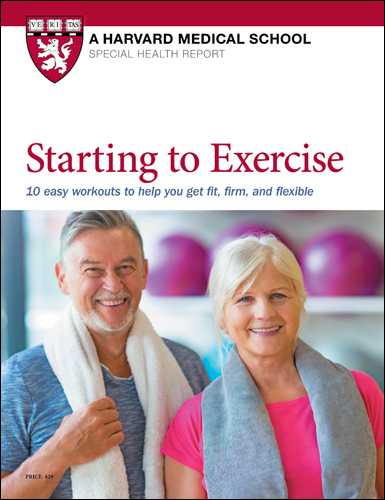3 easy ways to get active — right now

New year, new you? Forget the mindset that January 1 is the only time to restart your commitment to being active. Don’t wait. Begin today, right now. Jumping right into exercise is often the best way to push past any mental or emotional barriers. Or, as the famous slogan reminds us, “Just do it.”
Still not sold? Try this: you don’t have to embrace a complex workout program or a strict exercise schedule. Instead, begin small and focus on making regular activity a daily habit.
Three easy ways to add activity to your day
Here are three strategies you can adopt to get active and help build discipline and confidence. Try one for a week or two, and then evaluate. Not your thing? Do one of the others, or mix and match.
1. Do a five-in-five workout. If the traditional 30-minute workout feels too intimidating, fear not. You can do a great, all-around workout in just five minutes. Here’s how: do each of the following four exercises for 20 seconds, rest for 10 seconds, and then repeat to complete one minute. (Repeat any exercise for your final round.) For a challenge, do each exercise one time for 50 seconds then rest for 10 seconds. You’ll be sweaty and energized in no time.
- Jumping jacks: This exercise raises your heart rate, helps warm up the body, and builds lower body strength.
- Air squats: Squats build your leg and hip muscles. Squat either with a shoulder-width stance with your feet pointed straight ahead, or a wider stance where your feet are wider apart than your shoulders and pointed outward at a 45° angle. (A wider stance is often easier, as you don’t have to squat as far.)
- Push-ups: This works the shoulders, triceps, and chest at the same time. If you can’t do a traditional push-up, perform them on your knees or against the wall.
- Plank: This move works your entire core and lower back. Make sure to keep a straight back and don’t raise or dip your hips. If this is too difficult, hold the plank position while on your knees.
2. Add activity to daily routines. You have to do specific tasks every day, so use those moments to sneak in some movement. For example, walk around your neighborhood for 10 to 20 minutes after lunch or dinner; do your age in push-ups or sit-ups as soon as you wake up; perform 20- to 30-second planks while waiting for your coffee to brew.
3. Place fitness in full sight. Visual cues help keep exercise front and center. For instance, park your bicycle in full sight where you’ll see it regularly. Place your running shoes by the front door and store dumbbells outside the bathroom or kitchen. Or dress for success — in workout clothes, that is — whenever you can.
About the Author

Matthew Solan, Executive Editor, Harvard Men's Health Watch
Disclaimer:
As a service to our readers, Harvard Health Publishing provides access to our library of archived content. Please note the date of last review or update on all articles.
No content on this site, regardless of date, should ever be used as a substitute for direct medical advice from your doctor or other qualified clinician.













